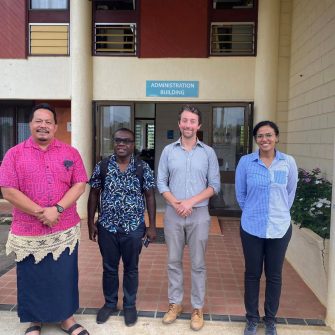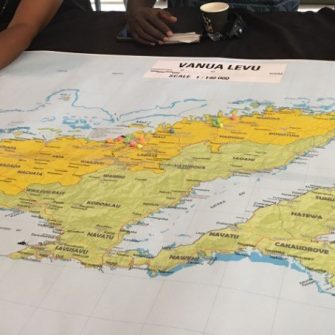Harnessing the power of nature-based solutions

Why Project Halophyte?
Mangroves are a type of halophyte — a salt-loving plant that grows in or near tidal water sources. Because of their remarkable environmental capabilities, we see global mangrove ecosystems as a green ring (a halo!) that encircles the earth, delivering better outcomes for people and the planet.
The Pacific is not on track to meet any of the 17 United Nations Development Goals by 2030"
The challenge
As in other countries around the world, the coastlines of Pacific Island countries and territories face a variety of pressures. The impacts of a warming climate and the draining of coastal areas has reduced mangrove habitat, impacted natural tidal cycles and degraded important ecosystems.
In coastal communities, the impacts have been severe:
Environmental
Changes to tidal systems have increased flooding and coastal erosion risk. Mangrove ecosystem loss is resulting in reduced carbon sequestration, declines in marine and estuarine water quality, reduced biodiversity and a decrease in sustainable fishing yields. Impact on the health and biodiversity of adjacent seagrass and coral reef ecosystems are also of grave concern.
Economic
Coastal farmers face increasing pressures due to the degradation of lands and crop yields. Decreasing profitability can lead to reduced climate resilience and wellbeing for farmers and coastal communities. Degraded coastal environments also negatively impact fisheries, coastal protection and tourism and the livelihoods they support.
Social/Cultural
Reduced income and environmental integrity has a direct impact on health, wellbeing and educational outcomes. Mangrove ecosystem loss also impacts fishing and recreation activities, increases flooding risk, and limits the harvesting of mangroves for wood, fuel products, and traditional foods and medicines.
The solution
Researchers from UNSW Sydney and the University of the South Pacific (USP) will transfer two large-scale nature-based solutions developed at UNSW and pilot them in Viti Levu, Fiji. In partnership with local communities, the research team will seek to re-instate natural tidal flows and revitalise the local mangrove ecosystems for the benefit of people and the environment.
Tidal restoration of blue carbon ecosystems
Sea walls and tidal gates interrupt normal tidal cycles, cutting off mangrove seascapes. Existing efforts to restore mangroves in these regions has typically resulted in high failure rates. A novel lifecycle approach developed at UNSW offers an alternative method to maximise outcomes and increase on-ground success. This approach:
- supports the regrowth of blue carbon ecosystems, including mangrove forests
- drives enhanced environmental, economic and social outcomes.
Floating mangrove pontoons: a halophyte revolution
Imagine a mangrove habitat. Now, imagine that same habitat floating as an island, providing sustainable ecosystem services and a protective shield for vulnerable coastlines. Based on techniques developed in partnership with UNESCO in UNSW wave flumes, UNSW and USP researchers are designing novel floating mangrove technology with the aim of:
- reducing deforestation pressures on existing mangrove habitats
- increasing coastal blue carbon sequestration
- improving water quality and decreasing wave energy
- integrating nature-based solutions into maritime structures
- greenifying an increasingly urbanised world.
This work will underpin the natural power of blue carbon ecosystems and help rejuvenate coastal spaces that support tourism and other industries
Fiji propagules.
The benefits
Over five years, researchers will track the environmental, social, and economic outcomes of Project Halo in Viti Levu, Fiji.
Expected benefits include:
Suva municipal market.
Environmental
- Increase in healthy mangrove, seagrass and coral reef habitats
- Improved marine and estuarine water quality
- Increased biodiversity levels
- Enhanced carbon sequestration
- Improved shoreline protection
Social
- Potential for diversified household income and wellbeing resulting from blue carbon farming
- Incorporation of traditional knowledge and values into nature-based solutions
- Community willingness to support climate change adaptation activities
- Contribution to the United Nations Sustainable Development Goals
Economic
- Increased family/community incomes
- Increased on-farm yields
- Willingness to uptake nature-based economic solutions
- Growth in local tourism opportunities
Charting a path towards the SDGs
Project Halo is designed to support the UN’s 2030 Sustainable Development Goals and 2021-2030 Decade of Ecosystem Restoration. As well as building international environmental science and engineering workforce capacity, this research positions Fiji as a global leader in piloting innovative and ambitious approaches to address climate change. It offers significant potential for other countries in the South Pacific and for the Blue Pacific Continent.
The SDGs wedding cake.
Mangroves are blue carbon superheroes
- Mangroves store 4x more carbon than terrestrial forests.
- They take up 5% of global coastal area but sequester around 15% of coastal carbon.
- Mangrove soil can store up to 76.5% of the carbon from the surrounding ecosystem.
- Mangroves’ branch and root structure provides an ideal breeding ground for juvenile coral and fish Around 30% of global fish species are mangrove dependent.
- Mangroves are also home to various bird species, including egrets, herons, kingfishers, hawks and osprey.
- Mangroves filter nutrients from surrounding waters by trapping sediments and limiting water movement.
- In some cases, they can also keep pace with sea-level rise through a process called ‘vertical accretion’ that helps them adapt to the challenges of climate change.
- Mangroves play an important role in shoreline protection by mitigating the power of waves and storm surges.
The power of blue carbon
Blue carbon is the carbon sequestered by coastal vegetation. Mangroves are a key blue carbon ecosystem — they’re one of the most carbon-rich forests in the world. Farmers who grow and conserve blue carbon ecosystems can generate and sell blue carbon credits to create an alternative income stream. These credits recognise the positive impacts of blue carbon farming on the local and global community.
Meet our researchers
Project Halo is a five-year partnership between UNSW Sydney and the University of the South Pacific, supported by philanthropic funding from Swire Shipping.
Join our Team!
We are recruiting for PhD researchers to join our team in a range of research areas. See PhD position descriptions under more details. Successful candidates will work in a fully immersive international team and have the opportunity to enrol in a Cotutelle PhD program should they wish, being awarded a PhD degree from both UNSW and USP.
Expressions of interest due 25th April 2025
Application Deadline 9th May 2025
How you can help
Join us to make change.
Supporting UNSW, whether through donations or partnerships, means supporting the next wave of discovery and all the possibilities that come with it. It means playing a vital role in the future we create together for future generations to prosper.
Connect with our expert researchers or contact our UNSW Giving Team via email: philanthropy@unsw.edu.au
Phone +61 2 8936 4700



